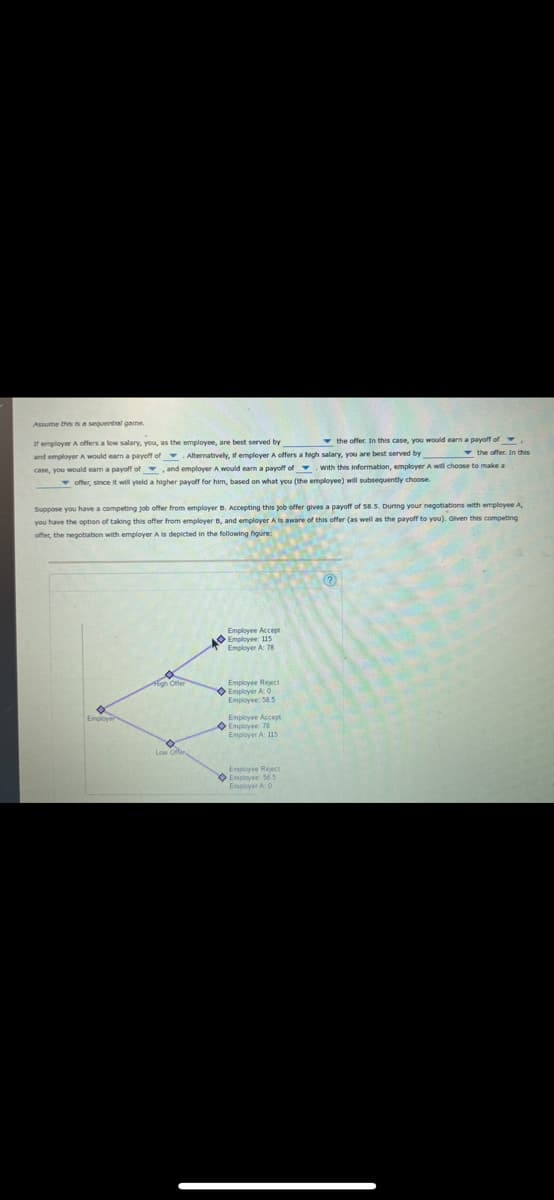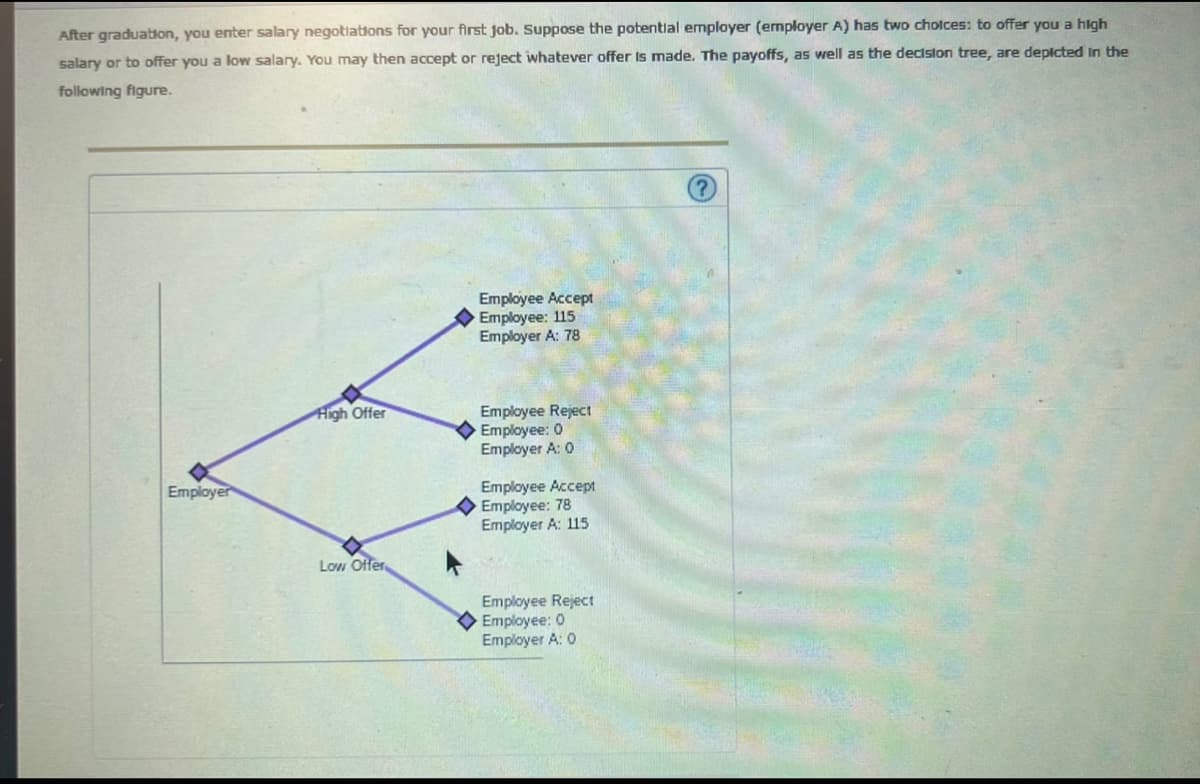Assume ths Nasequental game. If employer A offers a lew salary, you, as the employee, are best served by v the offer In this case, you would earn a payoff of -the offer. In this and employer A would earn a payoff of Alternatively, if empleyer A offers a high salary, you are best served by case, you wouid eam a payoff of and employer A would earn a payoff of .with this information, employer A will choose to make a offer, since it will yeld a higher payoff for him, based on what you (the employee) will subsequently choose. Suppose you have a competing job offer from employer B. Accepting this yob offer gives a payoff of se.s. Durting your negotiations with employee A you have the option of taking this offer from employer B, and employer A is aware of this offer (as well as the payoff to you). Given this competing offer, the negotiation with employerAs depicted in the following hgure Employee Accept Employee 115 Employer A 78 Employee Reject Employer AO Employee 58.5 Offer Employee Accep Employee: 78 Enployer A 15 Employer Low Oe Enloyee Rect OImployee 55 Employer A 0
Assume ths Nasequental game. If employer A offers a lew salary, you, as the employee, are best served by v the offer In this case, you would earn a payoff of -the offer. In this and employer A would earn a payoff of Alternatively, if empleyer A offers a high salary, you are best served by case, you wouid eam a payoff of and employer A would earn a payoff of .with this information, employer A will choose to make a offer, since it will yeld a higher payoff for him, based on what you (the employee) will subsequently choose. Suppose you have a competing job offer from employer B. Accepting this yob offer gives a payoff of se.s. Durting your negotiations with employee A you have the option of taking this offer from employer B, and employer A is aware of this offer (as well as the payoff to you). Given this competing offer, the negotiation with employerAs depicted in the following hgure Employee Accept Employee 115 Employer A 78 Employee Reject Employer AO Employee 58.5 Offer Employee Accep Employee: 78 Enployer A 15 Employer Low Oe Enloyee Rect OImployee 55 Employer A 0
Chapter7: Uncertainty
Section: Chapter Questions
Problem 7.7P
Related questions
Question

Transcribed Image Text:Assume thisis a sequential game.
If emplover A offers a low salary, you, as the employee, are best served by
offer. In this case, you would earn a payoff of
and employerA would earn a payoff of Alternatively, if employer A offers a high salary, you are best served by
case, you would eam a payoff of , and employer A would earn a payoff of .With this information, employerA will choose to make a
v offer, since it will yteld a higher payoff for him, based on what you (the employee) will subsequently choose.
Suppose you have a competing job offer from employer B. Accepting this job offer gives a payoff of 58.5. During your negotiations with employee A
you have the option of taking this offer from employer B, and employer A is aware of this offer (as well as the payoff to you). Given this competing
offer, the negotiation with employer A is depicted in the following hgure:
Employee Accept
O Employee: 115
Employer A 78
Employee Reject
O Empiover A 0
Employee: 58.5
Employee Accept
Employee: 78
Employer A 115
Employee Reect
O Employee: 56.5
Employer A0

Transcribed Image Text:After graduation, you enter salary negotiatons for your first job. Suppose the potential employer (employer A) has two cholces: to offer you a high
salary or to offer you a low salary. You may then accept or reject whatever offer is made. The payoffs, as well as the decision tree, are depicted in the
following figure.
Employee Accept
Employee: 115
Employer A: 78
Employee Reject
Employee: 0
Employer A: 0
High Offer
Employee Accept
Employee: 78
Employer A: 115
Employer
Low Offer
Employee Reject
Employee: 0
Employer A: 0
Expert Solution
This question has been solved!
Explore an expertly crafted, step-by-step solution for a thorough understanding of key concepts.
This is a popular solution!
Trending now
This is a popular solution!
Step by step
Solved in 2 steps

Knowledge Booster
Learn more about
Need a deep-dive on the concept behind this application? Look no further. Learn more about this topic, economics and related others by exploring similar questions and additional content below.Recommended textbooks for you

